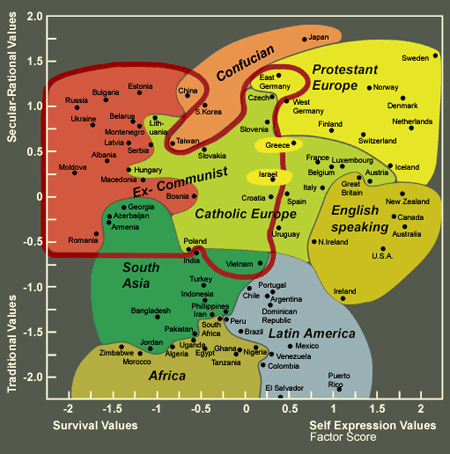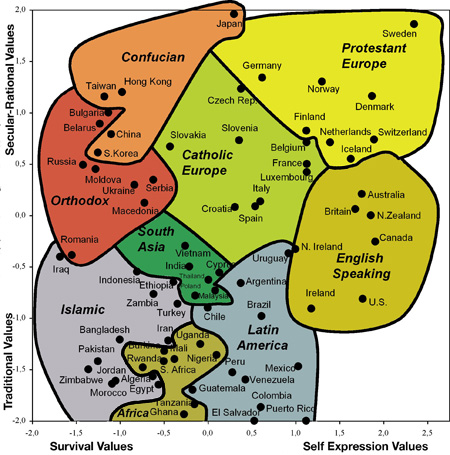For the part of the world who have found it a point to notice that there is such a country as Sweden – at some distance easily mixed up with Switzerland – Sweden might appear as somewhat of an ideal state of equality, untroubled by racial riots and religious taboos.
On close encounter a different picture emerges that speaks about a state of denial that have grown into a culture of its own. In a time when globalization is increasingly becoming a non-issue, when through the Internet Syria is as close as Malmö, this phenomenon might become a problem. The problem, being that the wider meaning of the word ‘culture’ in Sweden has been obscured and cemented into oblivion so much that there are almost no words there to talk about the fact that values, beliefs, religions and various ideas about what is right or wrong are different in different parts of the world.
Defining culture
In the early 2000s when I began to prepare my research for my doctoral thesis in the field of managing across cultures and leadership across cultures, it appeared that almost every author touching upon the topic of culture had come up with a definition of their own. Already during the 1950s, Alfred Kroeber and Clyde Kluckhohn had compiled a list of 164 definitions. The definitions spanned fine arts and humanities, pattern of human knowledge, beliefs and behavior, shared attitudes, values, goals and practices. Everything from cultivating small societies of bacteria in a Petri dish to my favourite, Geert Hofstede, who defined culture as a ‘collective programming of the mind’. It appeared that the only common ground was the agreement that there was such a thing as culture and in its broader sense all were the creations of man to fit in between them and what was given by nature to make just about any place on earth inhabitable. Thus, of course, any ”culture” would vary with the places and be whatever served its purpose best at that place.
This wider definition made for three simple observations:
- There is such a thing as culture
- They vary with their geographical location
- Their usefulness will vary since what is useful in one place will be plain stupid in another
What we arrive at in the most secular country in the world is however, the contradiction that the Swedes do not believe in the thesis of Greek philosopher Protagoras, that ”man is the measure of all things” but would much rather go with the Old Testament’s belief in absolute truths, that what is true to one man is true to all.
When I went on in the course of my research and talked to Swedish top managers about their ”management style”, asking if they felt that their ’style’ would broadly correspond to the ”Swedish culture and values” most Swedes would have it that there did not exist any particular Swedish management style, and certainly no framework of a Swedish national culture that influenced this non-existent “Swedish management style”.
Furthermore an entire afternoon fika session at the university saw a colleague of mine argue that the concept of national culture as such was a huge conspiracy and that everyone all over the world was in effect the same; with the same values, same beliefs and same behaviour.
Needless to say, that fika period took on a deeply philosophical turn and what I had hoped to take away from that discussion in terms of concrete definitions and a taxonomy of culture, much in line to Hofstede’s work, failed to materialize. In fact, their fervent insistence of the non-existence of a Swedish management style made the task of researching Swedish and Chinese management styles even more challenging, the plethora of definitions of ‘culture’ coming in direct opposition to the Swedes firm belief that there was no such thing as a Swedish management style based on Swedish culture.
Secondary sources of information in the local mass media seemed to contradict this.
Coming from a Hallidayan perspective of a functional view of language that includes the reflection of dominant social ideologies in the use of language, I found it most interesting to explore the meanings from language that arise from and underlie any paradigmatic choice of words. But my observations and findings were accidental, as most research findings often are – that it is not what is said – that lent a new perspective to what is being studied – but what was left unsaid, that drew up just as interesting a phenomenon.
But there is no ‘Swedish culture’
Looking for articles on values and beliefs it would have seemed natural to anyone to look for the word ‘culture’, but to my surprise, what was referred to by the word ‘culture’ in Swedish media, right up to and including the Swedish Ministry of Culture were related to the arts, music, dance, theater, museum installations and even – sports. The Ministry of Culture’s Model of cultural cooperation – culture closer to citizens for example was defined as a collaboration with the Arts sector, with the Swedish Arts Council. What was little addressed by the Ministry of Culture were the aspects of race, religion, language, beliefs and traditions of the people who are of different cultural backgrounds in Sweden.
The issue of creating a public awareness that the definition of culture goes beyond the realm of arts and sports is relevant since the Swedish society at large will both need and witness an increase in global mobility in their population whether due to political, social or business reasons.
This non-recognition of the wider aspect of culture in the public domains in terms of values and beliefs is to a large part reflected also in the country’s approach to foreign immigrants with a strategy of assimilation rather than integration. That the two words are often used associatively with each other, some even using them interchangeably adds confusion to the concepts, since the results of the policies and approach to migrant situations in Sweden will differ quite drastically depending on the overarching ideology of whether Sweden prefers an approach to foreigners that is more assimilative or integrative.
Assimilation and integration are different concepts altogether, which is not readily recognized in the debate. Assimilation is when different groups have blended so much that they are inseparable turned into one. If we have learnt anything from history that would be that this rarely happens. The other approach is integration, in which a society makes it possible – and allowed – to be different. To create systems that allows for differences instead of trying to make or waiting for everybody to become identical.
Sweden’s conscious assimilative efforts can be found not just in the lack of public address in the use of the word ‘culture’ to refer to a people’s system of values and beliefs, but at an operative level towards immigrants in the syllabus of Swedish language courses for immigrants for example, content range from how to make police reports or reports to the sjukkassan in Sweden, to reading high-level literature that includes generally depressing literature such as Strindberg. Even the more ‘cultural’ values of Swedes that is not fully addressed for example is why so much herring on the menu? Or what is Pingstdagen, or why this dancing around the Midsummer Pole?
Events deeply connected to what would be Swedish socio-cultural history is simply omitted in the language courses for immigrants.
The subjects addressed and the manner of delivery in the textbooks all suggest the cold pragmatic manner in which foreigners are expected to assimilate as in with the best of intentions, disappearing, once having arrived in Sweden – the sooner the better. Besides which, there would also be not many job opportunities should you not learn the language, no matter if you were a post-graduate or a medical doctor in a specialist field.
Talent drain and lack of future leadership as part consequences of ‘no culture’ in Swedish public discourse
This consistent slant in the use of the word culture at most institutional levels of the society (save the academic institutions), to refer to fine arts and public entertainment scene in the Swedish mass media and governmental discourse could be coincidental or even insignificant, but the consequences are evident within the social fabric of the Swedish society and the nation is already facing some difficulties.
Sweden’s want for homogeneity leaves room for a greater debate that is currently ongoing for Swedish immigrants in New York, as reflected in Medufia ”Keke” Kulego’s story and Blatte United in The Local.
In 2009, Svenska Dagsbladet, ran several articles on leadership in organizations in Sweden. In an article entitled ”Vem vill ta över” (Who will want to take over) Agneta Lagercrantz quoted Bengt Lejsved, a Swedish headhunter who has been in the field for twenty years who was worried about the lack of interest among the younger generations to take over the future top management positions. He foresaw that Sweden as a nation would need to look abroad, to Africa or the Middle East for example, for their future leaders of Swedish corporations. Something he was hesitant about the fesability about since he foresaw cultural problems ”because Sweden is not exactly world champions on integration”.
In another article entitled “Ledarskap i globaliseringstid”, Lagercrantz gathered pointers from prominent thought leaders in the field on the forms of future leadership for Sweden with the conclusion that the general consensus from a conference on the future of management held in 2009 by IFL in Stockholm and Globaliseringsrådet is that ”there is no typical Swedish leadership you can lean against for support in the globalization era” – a conclusion that still reflects Sweden’s denial of culture or ”culture of denial” in the land of lagom.
A culture of ‘no culture’: the Swedish ‘lagom’
Etymology aside, the concept of ‘lagom’ in layman Swedish language use refers generally to what is moderate, enough, just right or adequate. But even a brief overview of the Inglehart-Welzel Cultural Map of the World shows Sweden to be in a radical spot of its own. In fact, the survey reflects that Sweden had actually moved farther apart from its Nordic neighbours to a niche corner of its own from 2004 to 2008. Meaning to say that not only is Swedish culture in a complete class of its own on the world map, but that the Swedish ‘lagom’ is anything but.
Source: Ronald Inglehart and Christian Welzel, Modernization, Cultural Change and Democracy New York: Cambridg University Press, 2005: page 63. (World Values Survey)
Source: Ronald Inglehart and Christian Welzel, ”Changing Mass Priorities: The Link Between Modernization and Democracy.” Perspectives on Politics June 2010 (vol 8, No. 2) page 554.
In light of this information from the world values survey, would it not be more useful to begin from “within” and seek answers to Swedish leadership problems beginning with a look at what indeed is in the Swedish culture at large and reflected in its leaders, in the Swedish management culture and defining what makes Swedes distinct from even their closest neighbours? But the question remains – how can you begin from “within” if you do not first recognize the phenomenon of that there exists a Swedish management style, based on Swedish values and national culture?
And as noticed from the Svenska Globaliseringsrådet, talking about culture as a crucial aspect of global trade for Sweden becomes difficult when the government institutions insist that the way to success for Sweden is to water down Swedishness and go for a more ’global identity’ especially in management, and that Sweden’s main method of managing foreign immigrants living in Sweden is assimilation vaguely disguised as a feeble attempt to allow integration.
The place of culture in a globalized Sweden: What can be done?
With the Swedish government pushing for Sweden’s globalization on several fronts – the lack of proper address in the use of the word culture so much so that it cannot be used in its broader meaning without quite substantial explanations – is in the long run myopic and possibly dangerous, since it means that a whole gamut of socio-cultural problems that exist in the Swedish society cannot even be discussed. For how are we to discuss these problems systematically and efficiently when there isn’t even a proper name for them? Such is the two-edged sword of language, in a constant dialogic process between events, happenings and users.
Cultural change is a slow and sometimes difficult process, but in this age where globalization is overnight becoming a non-issue, isn’t it about time that Swedes themselves have a paradigm shift in ideology? The concerns of being egalitarian on several fronts could remain, but within that framework, shouldn’t it also be possible to acknowledge that all people are not alike and to say so doesn’t mean you are sexist, racist, discriminatory or prejudiced, and to acknowledge that Swedes do possess certain values of their own and, that these will be brought with them in terms of organization management and leadership, and that thinking so is not an original sin, meaning that you will burn in a hell they don’t even believe in anyway, forever?
At a societal level, acknowledging that people are different from each other and that different cultures in Sweden do exist (a result of its rather liberal immigrant policies), would also mean an acknowledgment of Swedish values and culture not just at home but abroad. It would also acknowledge that organizations do in fact send Swedes to foreign subsidiaries as “culture carriers”. What is needed in public discourse is the distinction that globalizing Sweden does not necessarily mean being non-Swedish, losing egalitarianism or that everyone needs to be ”the same”, but rather embracing differences, being aware of them and learning to work within such a framework.
And it is within this framework that perhaps the current challenge of talent drain and worries of future leadership can be properly addressed for Sweden. Issues that are urgent to the extent that it affects Sweden’s economic competitive edge in a time when the economies of Asia have come into their own.
As a Singaporean now living and working in Sweden, to Sweden, I’d say – Lets get on with it. Different is fun. Multicultural societies create interest and stimulate creativity. I for one, am looking forward to the added bonus of more pickled herring to the world!


